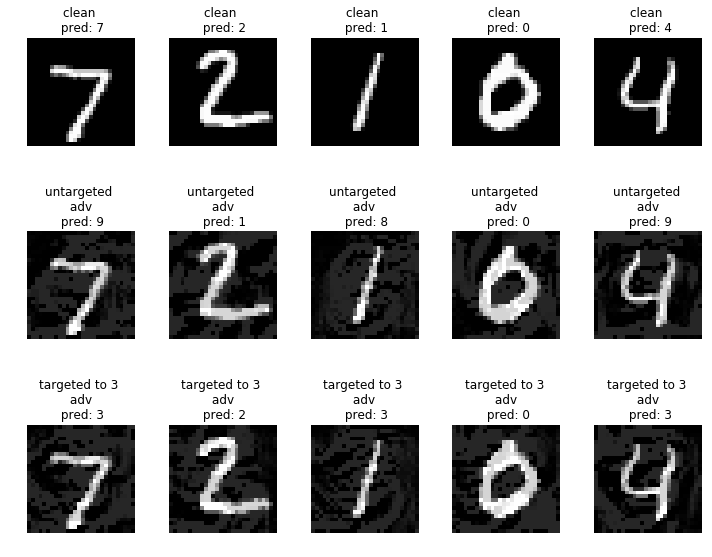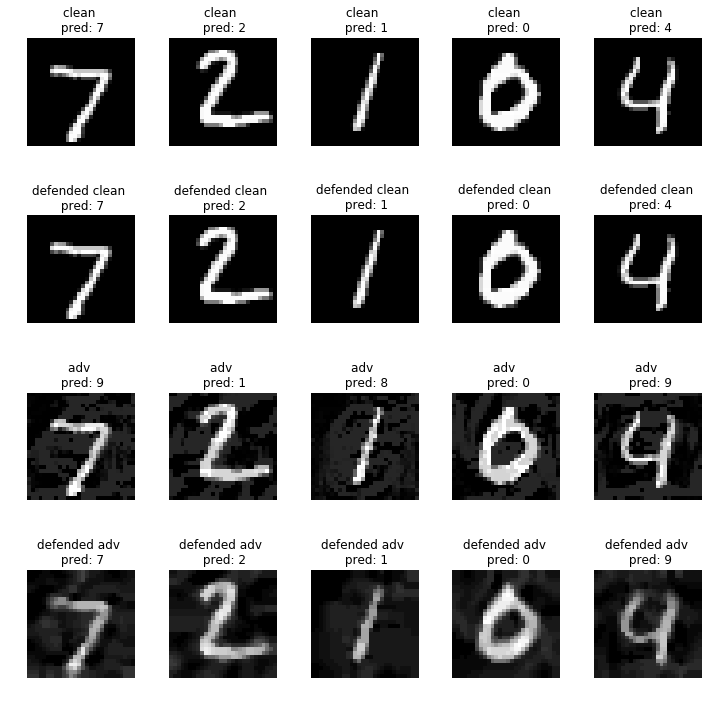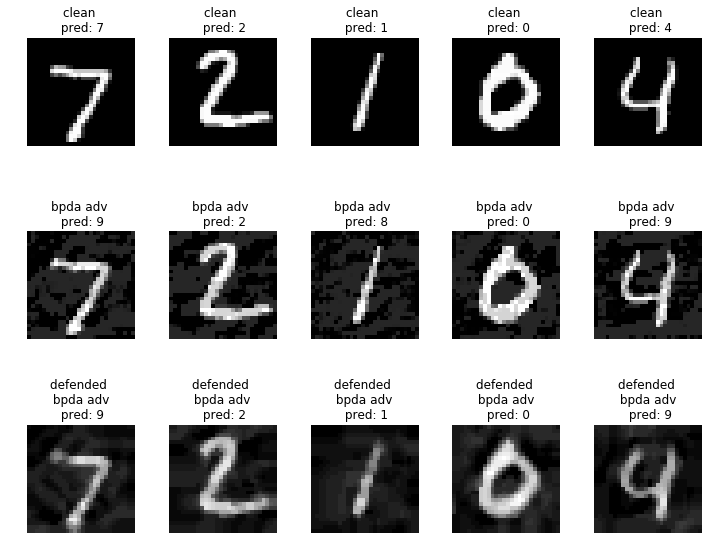Attack, Defense, and BPDA¶
[ ]:
# Copyright (c) 2018-present, Royal Bank of Canada.
# All rights reserved.
#
# This source code is licensed under the license found in the
# LICENSE file in the root directory of this source tree.
#
[1]:
import matplotlib.pyplot as plt
%matplotlib inline
import os
import argparse
import torch
import torch.nn as nn
from advertorch.utils import predict_from_logits
from advertorch_examples.utils import get_mnist_test_loader
from advertorch_examples.utils import _imshow
torch.manual_seed(0)
use_cuda = torch.cuda.is_available()
device = torch.device("cuda" if use_cuda else "cpu")
Load model that is trained with tut_train_mnist.py¶
[2]:
from advertorch.test_utils import LeNet5
from advertorch_examples.utils import TRAINED_MODEL_PATH
filename = "mnist_lenet5_clntrained.pt"
# filename = "mnist_lenet5_advtrained.pt"
model = LeNet5()
model.load_state_dict(
torch.load(os.path.join(TRAINED_MODEL_PATH, filename)))
model.to(device)
model.eval()
/home/gavin/anaconda3/envs/dev/lib/python3.6/site-packages/h5py/__init__.py:36: FutureWarning: Conversion of the second argument of issubdtype from `float` to `np.floating` is deprecated. In future, it will be treated as `np.float64 == np.dtype(float).type`.
from ._conv import register_converters as _register_converters
[2]:
LeNet5(
(conv1): Conv2d(1, 32, kernel_size=(3, 3), stride=(1, 1), padding=(1, 1))
(relu1): ReLU(inplace)
(maxpool1): MaxPool2d(kernel_size=2, stride=2, padding=0, dilation=1, ceil_mode=False)
(conv2): Conv2d(32, 64, kernel_size=(3, 3), stride=(1, 1), padding=(1, 1))
(relu2): ReLU(inplace)
(maxpool2): MaxPool2d(kernel_size=2, stride=2, padding=0, dilation=1, ceil_mode=False)
(linear1): Linear(in_features=3136, out_features=200, bias=True)
(relu3): ReLU(inplace)
(linear2): Linear(in_features=200, out_features=10, bias=True)
)
Load data¶
[3]:
batch_size = 5
loader = get_mnist_test_loader(batch_size=batch_size)
for cln_data, true_label in loader:
break
cln_data, true_label = cln_data.to(device), true_label.to(device)
Construct a LinfPGDAttack adversary instance¶
[4]:
from advertorch.attacks import LinfPGDAttack
adversary = LinfPGDAttack(
model, loss_fn=nn.CrossEntropyLoss(reduction="sum"), eps=0.15,
nb_iter=40, eps_iter=0.01, rand_init=True, clip_min=0.0, clip_max=1.0,
targeted=False)
Perform untargeted attack¶
[5]:
adv_untargeted = adversary.perturb(cln_data, true_label)
Perform targeted attack¶
[6]:
target = torch.ones_like(true_label) * 3
adversary.targeted = True
adv_targeted = adversary.perturb(cln_data, target)
Visualization of attacks¶
[7]:
pred_cln = predict_from_logits(model(cln_data))
pred_untargeted_adv = predict_from_logits(model(adv_untargeted))
pred_targeted_adv = predict_from_logits(model(adv_targeted))
import matplotlib.pyplot as plt
plt.figure(figsize=(10, 8))
for ii in range(batch_size):
plt.subplot(3, batch_size, ii + 1)
_imshow(cln_data[ii])
plt.title("clean \n pred: {}".format(pred_cln[ii]))
plt.subplot(3, batch_size, ii + 1 + batch_size)
_imshow(adv_untargeted[ii])
plt.title("untargeted \n adv \n pred: {}".format(
pred_untargeted_adv[ii]))
plt.subplot(3, batch_size, ii + 1 + batch_size * 2)
_imshow(adv_targeted[ii])
plt.title("targeted to 3 \n adv \n pred: {}".format(
pred_targeted_adv[ii]))
plt.tight_layout()
plt.show()

Construct defenses based on preprocessing¶
[8]:
from advertorch.defenses import MedianSmoothing2D
from advertorch.defenses import BitSqueezing
from advertorch.defenses import JPEGFilter
bits_squeezing = BitSqueezing(bit_depth=5)
median_filter = MedianSmoothing2D(kernel_size=3)
jpeg_filter = JPEGFilter(10)
defense = nn.Sequential(
jpeg_filter,
bits_squeezing,
median_filter,
)
Process the inputs using the defense¶
here we use the previous untargeted attack as the running example.
[9]:
adv = adv_untargeted
adv_defended = defense(adv)
cln_defended = defense(cln_data)
Visualization of defenses¶
[10]:
pred_cln = predict_from_logits(model(cln_data))
pred_cln_defended = predict_from_logits(model(cln_defended))
pred_adv = predict_from_logits(model(adv))
pred_adv_defended = predict_from_logits(model(adv_defended))
import matplotlib.pyplot as plt
plt.figure(figsize=(10, 10))
for ii in range(batch_size):
plt.subplot(4, batch_size, ii + 1)
_imshow(cln_data[ii])
plt.title("clean \n pred: {}".format(pred_cln[ii]))
plt.subplot(4, batch_size, ii + 1 + batch_size)
_imshow(cln_data[ii])
plt.title("defended clean \n pred: {}".format(pred_cln_defended[ii]))
plt.subplot(4, batch_size, ii + 1 + batch_size * 2)
_imshow(adv[ii])
plt.title("adv \n pred: {}".format(
pred_adv[ii]))
plt.subplot(4, batch_size, ii + 1 + batch_size * 3)
_imshow(adv_defended[ii])
plt.title("defended adv \n pred: {}".format(
pred_adv_defended[ii]))
plt.tight_layout()
plt.show()

BPDA (Backward Pass Differentiable Approximation)¶
BPDA is a method proposed in [1], which can be used to attack non-differentiable preprocessing based defenses. Here we use \(f(x)\) to denote a non-differentiable component, and \(g(x)\) to denote a differentiable component that is similar to \(f(x)\). In BPDA, \(f(x)\) is used in forward computation, and in the backward computation \(g(x)\) is used to propagate down the gradients.
Here we use BPDA to perform adaptive attack towards the defenses we used above.
[1] Athalye, A., Carlini, N. & Wagner, D.. (2018). Obfuscated Gradients Give a False Sense of Security: Circumventing Defenses to Adversarial Examples. Proceedings of the 35th International Conference on Machine Learning, in PMLR 80:274-283
[11]:
from advertorch.bpda import BPDAWrapper
defense_withbpda = BPDAWrapper(defense, forwardsub=lambda x: x)
defended_model = nn.Sequential(defense_withbpda, model)
bpda_adversary = LinfPGDAttack(
defended_model, loss_fn=nn.CrossEntropyLoss(reduction="sum"), eps=0.15,
nb_iter=1000, eps_iter=0.005, rand_init=True, clip_min=0.0, clip_max=1.0,
targeted=False)
bpda_adv = bpda_adversary.perturb(cln_data, true_label)
bpda_adv_defended = defense(bpda_adv)
[12]:
pred_cln = predict_from_logits(model(cln_data))
pred_bpda_adv = predict_from_logits(model(bpda_adv))
pred_bpda_adv_defended = predict_from_logits(model(bpda_adv_defended))
import matplotlib.pyplot as plt
plt.figure(figsize=(10, 8))
for ii in range(batch_size):
plt.subplot(3, batch_size, ii + 1)
_imshow(cln_data[ii])
plt.title("clean \n pred: {}".format(pred_cln[ii]))
plt.subplot(3, batch_size, ii + 1 + batch_size)
_imshow(bpda_adv[ii])
plt.title("bpda adv \n pred: {}".format(
pred_bpda_adv[ii]))
plt.subplot(3, batch_size, ii + 1 + batch_size * 2)
_imshow(bpda_adv_defended[ii])
plt.title("defended \n bpda adv \n pred: {}".format(
pred_bpda_adv_defended[ii]))
plt.tight_layout()
plt.show()
